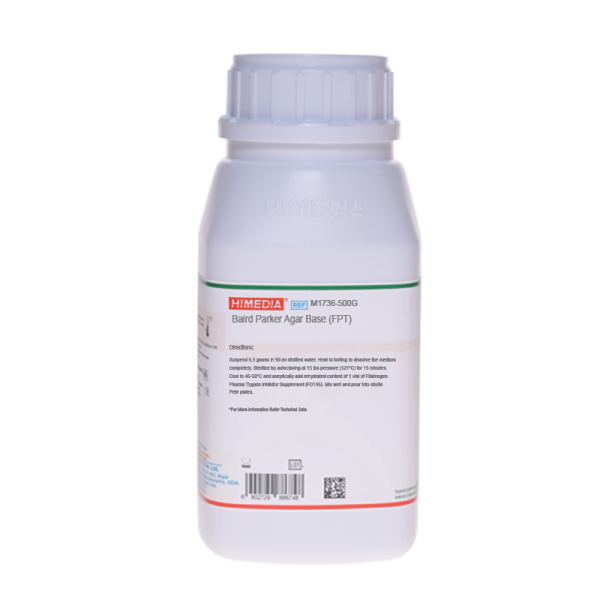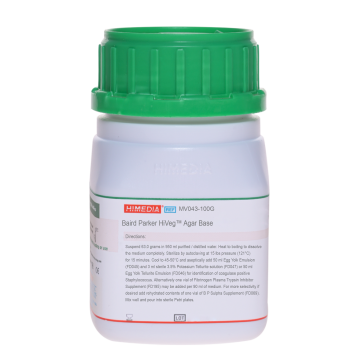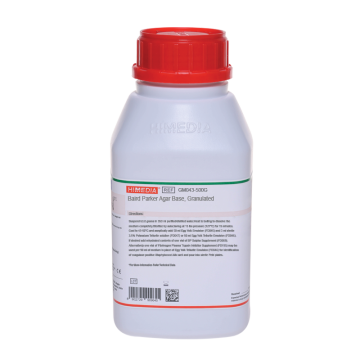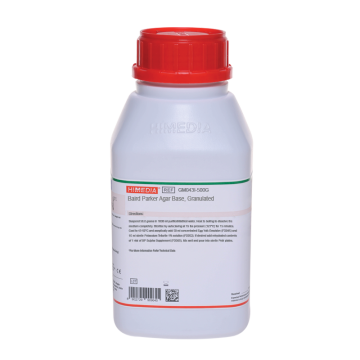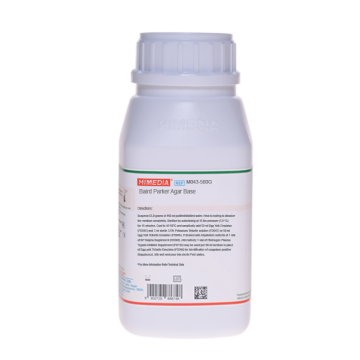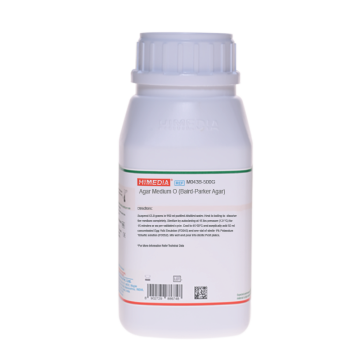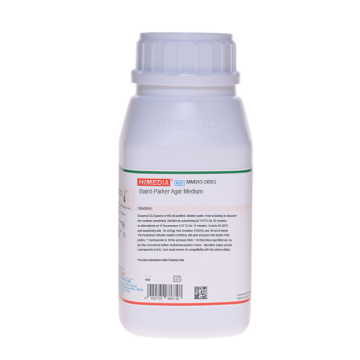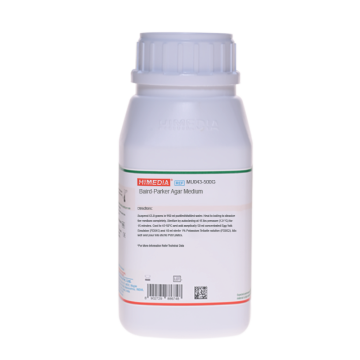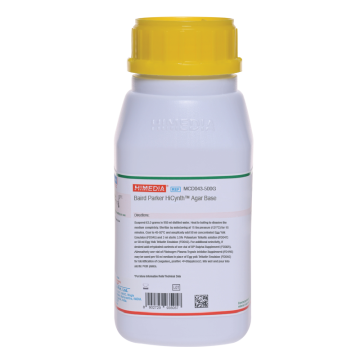 Your enquiry has been submitted
Your enquiry has been submitted
Baird Parker Agar Base (FPT)
Intended Use
Recommended for the isolation and enumeration of coagulase positive Staphylococci from food and other materials using FPT Inhibitor Supplement (FD195)
Composition**
| Ingredients | Gms / Litre |
|---|---|
| Tryptone | 10.000 |
| HM extract # | 5.000 |
| Yeast extract | 1.000 |
| Glycine | 12.000 |
| Sodium Pyruvate | 10.000 |
| Lithium Chloride | 5.000 |
| Agar | 20.000 |
Final pH ( at 25°C) 7.2±0.2
**Formula adjusted, standardized to suit performance parameters
# Equivalent to Meat extract
Directions
Suspend 6.3 grams in 90 ml purified / distilled water. Heat to boiling to dissolve the medium completely. Sterilize by autoclaving at 15 lbs pressure (121°C) for 15 minutes. Cool to 45-50°C and aseptically add rehydrated content of 1 vial of FPT Inhibitor Supplement (FD195). Mix well and pour into sterile Petri plates.
Principle And Interpretation
This medium is a modification of Baird-Parker Medium (M043) and is recommended for the selective isolation, enumeration and confirmation of Staphylococcus aureus from food and other specimens (1). This medium retains the Baird-Parker Agar Base, which has been specifically formulated to resuscitate injured cells (2). This medium differs from Baird-Parker Medium in that the egg yolk emulsion has been replaced by fibrinogen, rabbit plasma and trypsin inhibitor. The fibrinogen was added to enhance the coagulase reaction in the medium. The addition of rabbit plasma was found to be more specific for the coagulase activity when compared to other sources of plasma (3). Trypsin inhibitor was added to prevent fibrinolysis. Some strains of Staphylococcus aureus are sensitive to potassium tellurite when used at 0.01% w/v in Baird Parker Agar (M043). This modification of Baird Parker agar base gives comparable growth and selectivity to that achieved on Baird-Parker agar base (M043 and FD045, FD046, FD047). The reduction in potassium tellurite concentration in Baird Parker agar base results in Staphylococcus aureus strains forming white, grey or black colonies, which are surrounded by an opaque halo of precipitation, i.e. the coagulase reaction.
Sodium Pyruvate protects injured cells and helps recovery. Lithium Chloride and Potassium Tellurite inhibit most of contaminating microflora except Staphylococcus aureus. Glycine, pyruvate enhances growth of Staphylococcus. Upon further incubation, an opaque zone is developed around colonies which can be due to lipolytic activity.
On this medium Staphylococcal coagulase positive colonies are white to grey-black surrounded by an opaque zone of coagulase activity within 24-40 hours incubation at 35°C. Reduction in tellurite is necessary because of absence of egg yolk emulsion. This results in translucent agar and white to grey coloured colonies of Staphylococci. For quantitative results select 20 - 200 colonies. Count Staphylococcus aureus like colonies and test them for coagulase reaction. Report Staphylococcus aureus per gram of food.
Type of specimen
Food samples
Specimen Collection and Handling
For food samples, follow appropriate techniques for sample collection and processing as per guidelines (4). After use, contaminated materials must be sterilized by autoclaving before discarding.
Warning and Precautions
Read the label before opening the container. Wear protective gloves/protective clothing/eye protection/ face protection. Follow good microbiological lab practices while handling specimens and culture. Standard precautions as per established guidelines should be followed while handling specimens. Safety guidelines may be referred in individual safety data sheets.
Limitations
- Staphylococcus species other than coagulase positive Staphylococcus aureus also grow on this media.
- Further biochemical and serological tests are necessary for confirmation.
- Individual organisms differ in their growth requirement and may show variable growth patterns on the medium.
Performance and Evaluation
Performance of the medium is expected when used as per the direction on the label within the expiry period when stored at recommended temperature.
Quality Control
Appearance: Cream to yellow homogeneous free flowing powder
Gelling: Firm, comparable with 2.0% agar gel.
Colour and Clarity: Basal medium : Amber coloured clear to slightly opalescent gel. After addition of Fibrinogen plasma trypsin inhibitor supplement (FD195): Amber coloured opalescent gel forms in Petri plates
Reaction: Reaction of 6.3% w/v aqueous solution at 25°C. pH : 7.2±0.2
pH: 7.00-7.40
Cultural Response: Cultural characteristics observed with added FPT Inhibitor Supplement (FD195), after an incubation at 35-37°C for 24-48 hours.
| Organism | Inoculum (CFU) | Growth | Recovery | Colour of colony | Lecithinase |
|---|---|---|---|---|---|
| Bacillus subtilis subsp. spizizenii ATCC 6633 (00003*) | 50-100 | none - poor | <=10% | dark brown matt | negative |
| Micrococcus luteus ATCC 10240 | 50-100 | fair-good | 30-40% | shades of brown-black (very small) | negative |
| Proteus mirabilis ATCC 25933 | 50-100 | good - luxuriant | >=50% | brown - black | negative |
| Staphylococcus aureus subsp. aureus ATCC 25923 (00034*) | 50-100 | good - luxuriant | >=50% | grey-black shiny | positive, opaque zone around the colony |
| Staphylococcus epidermidis ATCC 12228 (00036*) | 50-100 | fair-good | 30-40% | black | negative |
| Escherichia coli ATCC 25922 (00013*) | >=10⁴ | inhibited | 0% |
Key : (*) Corresponding WDCM numbers.
Storage and Shelf Life
Store between 10-30°C in a tightly closed container and the prepared medium at 2-8°C. Use before expiry date on the label. On opening, product should be properly stored dry, after tightly capping the bottle in order to prevent lump formation due to the hygroscopic nature of the product. Improper storage of the product may lead to lump formation. Store in dry ventilated area protected from extremes of temperature and sources of ignition. Seal the container tightly after use. Product performance is best if used within stated expiry period.
Disposal
User must ensure safe disposal by autoclaving and/or incineration of used or unusable preparations of this product. Follow established laboratory procedures in disposing of infectious materials and material that comes into contact with sample must be decontaminated and disposed of in accordance with current laboratory techniques (5,6).
Reference
- Baird-Parker, A.C. and Davenport, E., 1965, J. Appl. Bact., 28:390.
- Zebovitz, E., Evans J.B. & Niven C.F., (1955), J. Bact., 70: 686.
- Baird-Parker, A.C. 1962, J .Appl. Bact, 25: 12-19
- Salfinger Y., and Tortorello M.L. Fifth (Ed.), 2015, Compendium of Methods for the Microbiological Examination of Foods, 5th Ed., American Public Health Association, Washington, D.C.
- Isenberg, H.D. Clinical Microbiology Procedures Handbook 2nd Edition.
- Jorgensen, J.H., Pfaller, M.A., Carroll, K.C., Funke, G., Landry, M.L., Richter, S.S and Warnock., D.W. (2015) Manual of Clinical Microbiology, 11th Edition. Vol. 1.
| Product Name | Baird Parker Agar Base (FPT) |
|---|---|
| SKU | M1736 |
| Product Type | Regular |
| Physical Form | Powder |
| Origin | Animal |
| Packaging type | HDPE |
| References | 1.Baird-Parker, A.C. 1962, J .Appl. Bact, 25: 12-192.Baird-Parker, A.C. and Davenport, E., 1965, J. Appl. Bact., 28:390. 3.Baer, 1971, J. Assoc. Off. Anal. Chem., 54: 732 4.Beckers N. J. et. al., 1984, Can. J. of Microbiol, 30: 470 5.International Organisation for Standardisation (ISO), 1999, enumeration of Staphylococcus aureus by colony counts technique Draft ISO/DIS 6888- |
| Customized Product Available | No |



